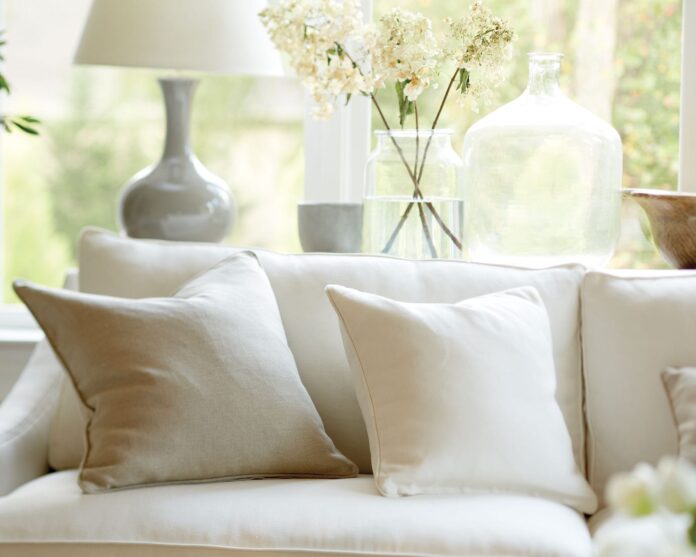Sofa stains are the last thing you want when trying to keep your house perfectly clean. They are difficult to remove and, if the blemishes sit for too long, they become a permanent problem. Try as you might to keep everything in your home immaculate, stains are practically inevitable. You should address the stains before they take over your life. Wouldn’t it be nice to have a stain-free sofa? If you have kids, pets, or if you’re just clumsy, you can protect your furniture from stains. Please take a look at these tips.
Upholster The Furniture in A Stain Proof Fabric
Using sofa protectors and slipcovers isn’t the ideal solution. They don’t fit perfectly tight – not to mention that these pieces can show wrinkles, especially after a wash. The maintenance of a sofa protector or slipcover, while convenient, is something to think about. Having the ability to remove the protective layer can be a blessing and a burden. You have to wash the sofa protector or slipcover in a cold cycle with mild detergent free of bleach or bleach additives. When you’re done, let the protective layer air-dry before putting it back on the sofa. You should always put it back on the furniture damp to finish drying. The question now is: Does this sound like anything you’d like to do?
Upholstering your sofa in a stain proof fabric will not only give it a new look but also provide a much-needed layer of protection. Stain resistance works by stopping liquids from being absorbed and fine particles adhering to the fabric. Since the furniture doesn’t absorb stains or spills, it becomes easier to clean and even lasts longer. You clean the mess quickly and move on with your life. If you have children, pets, or a large family, you don’t have to struggle to keep the sofa clean and in good condition. Stain proof fabric is perfect for furniture pieces that get a lot of traffic because it’s durable and easy to clean.
Regularly Vacuum to Remove Dust, Crumbs, And Pet Hair
Indeed, vacuuming is a chore, but it can help your sofa look better and last longer. Carry out regular maintenance to remove dust, crumbs, and pet hair. As a rule, vacuum the furniture on a weekly-to-monthly basis. Upholstered furniture is a breeding ground for germs and bacteria. If your sofa hasn’t been cleaned for a while, give it a deep clean. You don’t want your family to get allergies or infections because the sofa is dirty. Lift the cushions of the sofa and, with the help of a handheld vacuum cleaner, clean under the seat cushions and surrounding nooks that cover the frame. In the end, vacuum the cushions.
Before placing the cushions back on the sofa, give them a good fluffing. The cushions deserve a little pampering every now and then. Once you’ve given the sofa a quick vacuum, flip and rotate the cushions. Find the midpoint on each cushion’s side. Start pushing in and hit the sides swiftly. When you’re done with the sides, move on to the rest of the cushion. As a long-term solution, it’s recommended to take the cushions to an upholsterer. You can pick a fabric that matches your décor style and create the size of cushion you need. Just so you know, it’s not an expensive solution.
Have A Dry or Damp Cloth at Hand for Spot Treatment
Stain proof fabric withstands accidental spillages of red wine, juice, milk, or any type of liquid. Since they’re not absorbed right away, the stains can be wiped off using a dry or damp cloth. Simply put, you have an easy clean sofa. Use a soft bristle or microfiber cloth and wipe off the excess. Allow the fabric to dry before touching or sitting on the sofa. Don’t use a brush, as it can tear other fibres. Failing to use safe cleaning products can result in permanently damaged upholstery. See if there’s a customised technique for cleaning your sofa. This way, you can keep the upholstery fabric clean and increase the sofa’s lifespan.
If you have a tougher stain, you can easily clean it with soapy water. The less time the blemish has to soak in, the easier it will be to remove. Rub with gentle movements. Repeat the process a couple of times until the stain is gone. Don’t use an iron or a hair dryer even if the stain is causing you grief. Use a scraper if you’re battling stains like ketchup, mud, or silly putty. A teaspoon can make a good choice. Simply remove the residue with the edge of the utensil. What technique you use to treat a specific spot depends on its nature.
Change Your Clumsy Habits
Last but certainly not least, changing your habits can make a big difference. Even if you’re accident-prone, you don’t have to resign yourself to a life full of stains. Being clumsy is the result of a mental state, so you can make yourself less prone to mishaps by increasing your reaction time, processing speed, and level of concentration. Change your clumsy behaviour and habits. Begin to pay attention to what you do and what’s around you. Most importantly, avoid fast or jerky movements. If not, you’ll knock objects down.
If you have bad habits in the home, address them as soon as possible. Eating in the dining room or setting up a small table on the floor is a fantastic way to practice stain prevention. Have one, maximum two drinks so as to avoid an “Oops” moment. Get enough sleep at night to avoid any kind of accident. If you’re woozy when drinking your morning coffee, you risk spilling it. If you want to protect your investment in the sofa, consider changing your behaviours.
To sum up, the sofa can take quite a beating. The best way to protect your investment is to keep it stain free and clean for as long as possible. Removing stains can be frustrating. With a little bit of effort, you’ll be able to guard your precious household item against being soiled.



















